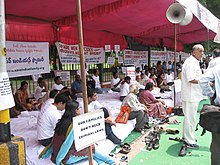남성인권 운동
(남성의 권리 운동에서 넘어옴)
남성인권(男性人權, men's rights)이란 남성운동 담론의 일부로서, 1970년대 초 남성해방 운동에서 파생되었다. 남성인권운동은 남성이 불이익 또는 차별 및 억압을 받는다고 생각되는 상황을 문제시한다고 주장한다.[1][2]

학계에서는 남성인권이라는 개념이 사실 여성주의에 대한 반발에 지나지 않는다고 생각하고 있다.[3] 남성인권운동가를 자칭하는 사람들은 남성이 사회적으로 더 많은 권력을 소유하고 있다는 생각에 도전하며, 여성운동이 "도를 넘어(gone too far)" 남성에게 상처를 입힐 지경이 되어 있다고 주장한다.
소위 "남성인권" 개념을 둘러싼 담론과 운동들은 남부빈곤법률센터를 비롯한 여러 전문가 및 학자들에게 비판의 대상이 되고 있다. 일부 남성인권운동가는 여성혐오자로 지칭되기도 한다.[4][5][6][7][8][9]
같이 보기
편집각주
편집- ↑ Gavanas, Anna (2004). 《Fatherhood Politics in the United States: Masculinity, Sexuality, Race, and Marriage》. Urbana: University of Illinois Press. 11쪽. ISBN 0-252-02884-8.
All these cases of perceived discrimination make up the men's rights view that men are considered, by government and society, to be more expendable than women.
- ↑ Stephen Blake Boyd, W. Merle Longwood, Mark William Muesse, 편집. (1996). 《Redeeming men: religion and masculinities》. Westminster John Knox Press. 17쪽. ISBN 978-0-664-25544-2.
In contradistinction to profeminism, however, the men's rights perspective addresses specific legal and cultural factors that put men at a disadvantage. The movement is made up of a variety of formal and informal groups that differ in their approaches and issues; Men's rights advocates, for example, target sex-specific military conscription and judicial practices that discriminate against men in child custody cases.
- ↑ See, for example:
- Maddison, Sarah (1999). “Private Men, Public Anger: The Men's Rights Movement in Australia” (PDF). 《Journal of Interdisciplinary Gender Studies》 4 (2): 39–52. 2013년 10월 20일에 원본 문서 (PDF)에서 보존된 문서.
- Doyle, Ciara (2004). 〈The Fathers' Rights Movement: Extending Patriarchal Control Beyond the Marital Family〉. Herrman, Peter. 《Citizenship Revisited: Threats or Opportunities of Shifting Boundaries》. New York: Nova Publishers. 61–62쪽. ISBN 978-1-59033-900-8.
- Flood, Michael (2005). 〈Men's Collective Struggles for Gender Justice: The Case of Antiviolence Activism〉. Kimmel, Michael S.; Hearn, Jeff; Connell, Raewyn. 《Handbook of Studies on Men and Masculinities》. Thousand Oaks: SAGE Publications. 459쪽. ISBN 978-0-7619-2369-5.
- Finocchiaro, Peter (2011년 3월 29일). “Is the men's rights movement growing?”. 《Salon》. 2013년 3월 10일에 확인함.
- Messner, Michael (2000). 《Politics of Masculinities: Men in Movements》. Lanham: Rowman & Littlefield. 41쪽. ISBN 978-0-8039-5577-6.
- Solinger, Rickie (2013). 《Reproductive Politics: What Everyone Needs to Know》. Oxford: Oxford University Press. 130쪽. ISBN 978-0-19-981141-0.
- Menzies, Robert (2007). 〈Virtual Backlash: Representation of Men's "Rights" and Feminist "Wrongs" in Cyberspace〉. Boyd, Susan B. 《Reaction and Resistance: Feminism, Law, and Social Change》. Vancouver: University of British Columbia Press. 65–97쪽. ISBN 978-0-7748-1411-9.
- Dunphy, Richard (2000). 《Sexual Politics: An Introduction》. Edinburgh: Edinburgh University Press. 88쪽. ISBN 978-0-7486-1247-5.
- Mills, Martin (2003). “Shaping the boys' agenda: the backlash blockbusters”. 《International Journal of Inclusive Education》 7 (1): 57–73. doi:10.1080/13603110210143644.
- ↑ Ruzankina, E.A. (2010). “Men's Movements and Male Subjectivity”. 《Archeology of Eurasia》 49 (1): 8–16.
- ↑ Glenn, Sacks. “Confronting Woman-Bashing in the Men's Movement”. 《glennsacks.com》. 2014년 8월 13일에 확인함.
- ↑ Potok, M; Schlatter S (Spring 2012). “Men's Rights Movement Spreads False Claims about Women”. 《Intelligence Report》 (Southern Poverty Law Center) 145. 2013년 3월 7일에 확인함.
- ↑ Chris Beasley (2005). 《Gender and Sexuality: Critical Theories, Critical Thinkers》. Thousand Oaks, CA: SAGE Publications. 180쪽. ISBN 978-0-7619-6979-2. 2015년 4월 10일에 확인함.
- ↑ Kimmel, Michael; Kaufman, Michael (1997). 〈Weekend Warriors〉. Mary R. Walsh. 《Women, Men and Gender》. Yale University Press. 407쪽. ISBN 978-0-300-06938-9.
- ↑ Menzies 2007, 71쪽.
| 이 글은 사회에 관한 토막글입니다. 여러분의 지식으로 알차게 문서를 완성해 갑시다. |